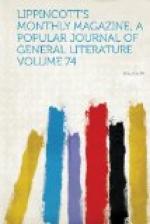[Illustration: Prof. S.F.B. Morse, the inventor of the electro-magnetic telegraph.]
Difficult as it is adequately to state or to measure the extension of the mails within the century, it is far from telling the whole story of the amplitude and celerity with which the people of our day interchange intelligence.
Only to the last third of the period under review has the electric telegraph been known. It is now a necessity of the public and private life of every civilized spot upon the globe. It traverses all lands and all seas. The forty miles of wire with which it started from Washington City have become many millions. Its length of line in the United States is about the same with that of the mail-routes, and a similar equality probably obtains in other parts of the world. We have nearly as much line as all Europe together, though the extent of wire may not be so great. It is little to say that this continent, so dim to the founders of the Union, has been by the invention of Morse compressed within whispering distance, the same advantage having been conferred on other countries. It is the property of mankind, and the comparison must be between present and past, not between any two countries of the present. Strictly, a comparison is not possible, nothing like magnetic communication having been known forty years ago, unless to the half imagination, half realization of one or two scientific experimenters. Steam and stamps wrought a difference in degree—the telegraph one of kind. Against eighteen hundred miles of wagon-road we set seventy-three thousand of railway; but two hundred thousand miles of telegraph are opposed by nothing, unless by Franklin’s kite-string. Looked at along the perspective of poles, the old days disappear entirely—the patriots become pre-historic. Yet modern self-conceit is somewhat checked by the reflection that the career of these two great agents of intercommunication has but just opened; that their management even yet remains a puzzle to us; and that the next generation may wonder how we happened to get hold of implements whose use and capabilities we so poorly comprehended. So far as prediction can now be ventured, a force and pathway more economical than coal and the rail will not soon be forthcoming; nor is Canton apt to “interview” New York at the rate of more words in a minute over a single wire than she can now. Some day dynamite may be harnessed to the balloon, which stands, or drifts, where it did with Montgolfier, and we may all become long-range projectiles; but even this age of hurry will contentedly wait a little for that.




